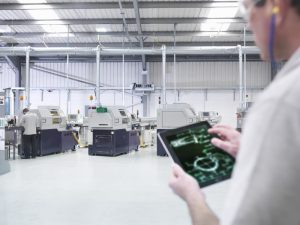In fast growth markets like the Middle East, supply chain stakeholders are moving quickly to deploy instrumentation for greater visibility and better tracking. The move towards supply chain transparency is a big issue. But how will it be helped or hindered by the proliferation of the Internet of Things (IoT)?
On the face of it, IoT will help the move towards supply chain transparency. IoT is likely to improve speed and accuracy of transaction processing, and also improve tracking and delivery issues. Even just a single check of an electronic tag in the course of an item’s journey could represent a major improvement on what is currently available, and IoT has much more potential to offer than this.
Supporting technologies and new business models
There are some obvious supporting technologies that are already being used. Many organisations are already embracing the potential of RFID technology, IoT devices and blockchains to improve their supply chain management. Retail organisations are early adopters of the technology, and showing how it can be used to support real-time demand planning. Adoption of some of these technologies has perhaps been slower than expected, but they are now proving their usefulness.
It seems likely that IoT will result in new business models, and redesign of supply chains. As a general principle, technology innovations first drive improvements, and then result in redesign and changes in how business is done. It therefore seems likely that the IoT will eventually result in a complete rethink of the supply chain. This redesign should allow transparency to be built in from the start, with data emerging from interconnected devices across the whole chain.
Data explosion requires analytics competence
 The explosion in data that will accompany IoT will be a big challenge. Many supply chain organisations are not prepared for the sheer volume of data that will be generated by IoT-connected supply chain components. Without suitable data collection and governance arrangements, organisations will miss the opportunity to generate insights, and learn anything from the data about demand or customer behaviour.
The explosion in data that will accompany IoT will be a big challenge. Many supply chain organisations are not prepared for the sheer volume of data that will be generated by IoT-connected supply chain components. Without suitable data collection and governance arrangements, organisations will miss the opportunity to generate insights, and learn anything from the data about demand or customer behaviour.
Developing analytics competence will be a key issue. There is a worldwide shortage of data scientists, and certainly very few are currently working in manufacturing. Developing the analytics skills in-house, or finding suitable options for outsourcing will be a major issue if organisations are to achieve supply chain transparency. Otherwise, the result of the arrival of the IoT is likely to be more noise, rather than more clarity.
Long-term change may require a different culture. Supply chain transparency needs a willingness to accept openness, including open data, and the use of data to improve operations. This, in turn, means a willingness to hear bad news as a way of improving services. Supply chain organisations do not necessarily have this open culture, which means that a culture change may well be necessary as part of achieving transparency.
Explore how artificial intelligence and machine learning applications are reshaping the supply chain of the future. Tune in to this on-demand webinar
Data security
Understanding data security issues is also an important area. The security of IoT-connected devices is already a major problem with at least two cyber-attacks being linked to connected devices. Manufacturers may be put off adopting IoT technology because of the security implications — or, perhaps worse, may be unaware of the issues, and add to the potential for their devices to be targeted by cyber-attackers.
Third party data, including IoT data from suppliers, could be both a help and a hindrance. Perhaps a better question would be to ask what the impact of a connected supply chain is likely to be on transparency. Research shows that 65% of manufacturers now have at least one IoT solution, so connected devices and supply chains are already a reality. But the concerns about data governance and security may be multiplied several-fold across several organisations.
Customer pressure could force IoT adoption in the supply chain. Customers have long been told that the IoT will result in benefits to them in terms of transparency. Projected benefits include, for example, real-time stock information to prevent wasted shopping trips. Customers may therefore press for IoT adoption by manufacturing and supply chain organisations, which will both provide impetus and concern about the reputational impact of failure.
Is your #SupplyChain organisation ready for the explosion in data that accompany #IoT ? #ConnectedSupplyChain Click To TweetIntegrated Business planning
Yet another aspect of supply chain optimization that IoT will impact is Integrated Business Planning (IBP). This practice combines the benefits of sales and operations planning (S&OP) with strategic planning in one seamless business management platform. IBP typically also addresses financial and operational planning challenges to create step change improvements.
Download an IIA research report focusing on asset performance analytics
